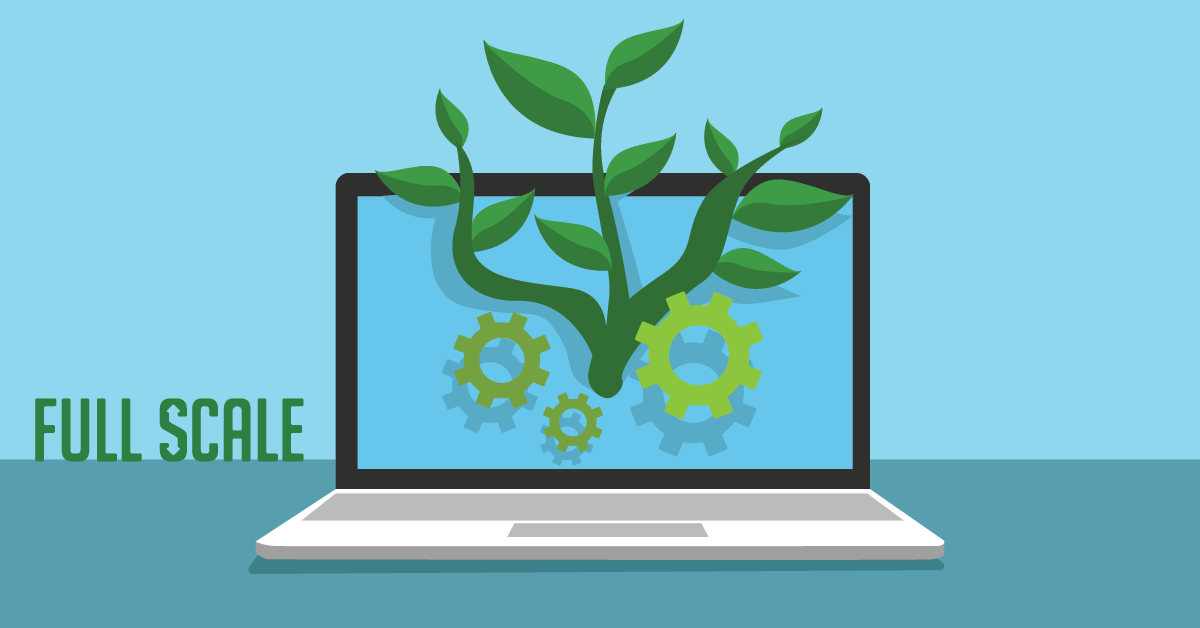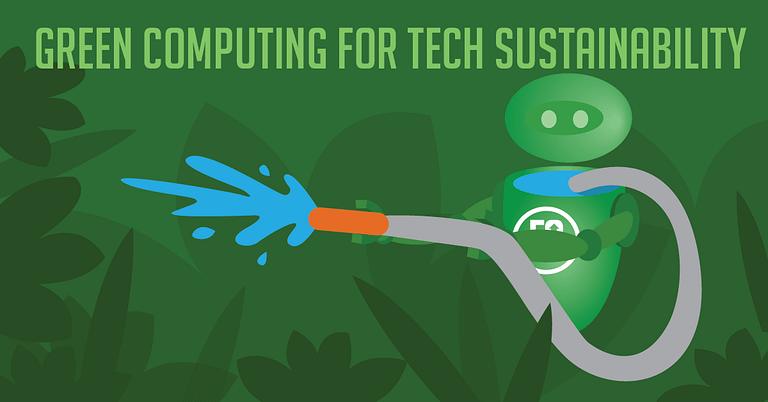Last Updated on 2024-10-11
All your devices and the data centers that power your apps can impact the environment. But with the rising popularity of green computing, we’re entering a new era of safeguarding our planet.
The revolutionary concept of green computing paves the way for a more sustainable future. It is reshaping the tech industry to reduce the carbon footprint of gadgets and other technologies.
In this blog post, we’ll explore the influence of green computing on technological sustainability. We’re spotlighting some inspiring examples of successful green computing projects. Moreover, we’ll take a sneak peek into the future of the intersection of technology and sustainability.
What Is Green Computing?
Green computing refers to designing, using, and managing computer systems and technologies in an environmentally responsible manner. It is also known as green IT or sustainable computing.
The idea aims to create a more sustainable tech ecosystem that benefits users and the planet. How? Minimize the impact of tech, reduce energy consumption, and promote the overall sustainability of IT operations.
The Influence of Green Computing on Tech Sustainability
How is green computing making waves in the realm of tech sustainability? The tech industry is known for being power-hungry—gobbling up electricity like there’s no tomorrow. But with the adoption of green computing practices, this narrative is changing for the better.
Here are some key ways in which green computing contributes to tech sustainability.
Reduced Energy Consumption
One of the most immediate and visible impacts of green computing is reducing energy consumption. You can lower your electricity usage by using energy-efficient hardware components. Also, you can optimize the power management settings of your devices. This lowers energy consumption costs and reduces greenhouse gas emissions.
Lower Carbon Emissions
The IT sector significantly contributes to global carbon emissions. That is why adopting energy-efficient technologies and practices helps mitigate your environmental impact. It also supports global efforts to combat climate change. But what can you do?
You can allow employees to work remotely if you’re a business owner. Telecommuting reduces the need for daily commuting and office space. As a result, it lowers carbon emissions and energy consumption.
Try to become less dependent on non-renewable energy sources, like fossil fuels. Furthermore, look for other practices to help lower carbon emissions.
Extended Equipment Lifespan
Green computing emphasizes the design and manufacturing of durable and long-lasting IT equipment. This reduces the frequency of hardware replacements, decreasing the amount of generated electronic waste (e-waste). Extending the lifespan of devices also conserves resources and reduces the need for constant production of new equipment.
Proper E-Waste Management
E-waste is a significant environmental concern. It’s not only an environmental threat but also a health hazard. Thus, proper e-waste management is a critical aspect of green computing.
By encouraging responsible disposal and recycling of electronic equipment, green computing helps prevent toxic materials from entering landfills. Recycling also allows for the recovery of valuable materials, reducing the demand for raw resources.
Optimized Resource Utilization
Green computing encourages efficient utilization of computing resources. You can do so through virtualization and cloud computing. They enable better allocation of resources, leading to reduced hardware requirements, lower energy consumption, and improved overall system performance.
Cloud services also provide scalability and resource sharing. They enable you and your organizations to use computing resources more efficiently without extensive on-premises hardware.
Innovation and Design
Green computing drives innovation in technology design. Manufacturers are incentivized to create more energy-efficient, durable products that are easier to recycle. This focus on sustainable design principles fosters the development of new technologies that align with environmental goals.
Are you a manufacturer of electronic devices? If so, you can help by lessening the consumption of non-renewable resources, such as rare metals and minerals in your products.
Moreover, developing energy-efficient and resource-efficient software applications is also part of green computing. Optimizing code, reducing resource consumption, and using efficient algorithms contribute to overall sustainability.
Corporate Social Responsibility
Embracing green computing reflects a commitment to corporate social responsibility. As a responsible business owner, you should prioritize sustainability in your IT operations and demonstrate your dedication to ethical practices. This can enhance your reputation and attract environmentally conscious customers and partners.
Sustainable Growth
By adopting green computing practices, you can continue to grow and innovate without significantly heightening environmental challenges. This enables sustainable technological advancement that meets your business’s needs without compromising future generations’ well-being.

Examples of Successful Green Computing Projects
Now, let’s dive into real-life success stories of green computing. One standout project is the green energy initiative in Ireland. The program includes the encouragement of data centers to commit to using renewable energy sources. It fosters a more environment-friendly approach to powering these hubs. By 2020, nearly 80% of Ireland’s data center energy came from renewable sources, proving that green computing isn’t just a pipe dream.
Another green-tastic project came from Microsoft. The tech giant has embarked on a mission to become carbon-negative by 2030. This means removing more carbon from the atmosphere than it emits. Their ambitious plan includes reducing emissions and investing in technologies that capture and remove carbon. This commitment to green computing sets a strong precedent for other industry giants to follow suit.
Last but not least is the one that forward-thinking companies like Google have done. They stepped up their game by implementing innovative programs, using renewable energy sources, and even repurposing waste heat. These initiatives decrease the carbon footprint of their data centers and set the stage for a more sustainable infrastructure for the future.
The Future of Green Computing in the Tech Industry
What does the future hold for the intersection of technology and sustainability? As we march into a more tech-dependent future, the demand for computing power will only skyrocket. But fear not, as the tech industry is stepping up its green game.
One promising concept lies in the development of energy-efficient hardware. Engineers are hard at work designing processors and devices that deliver top-notch performance without draining excessive power. Think of it as getting more bang for your buck regarding performance and energy savings.
Artificial intelligence also plays a pivotal role in the green computing revolution. Machine learning algorithms are used to optimize energy consumption in data centers. They can also predict equipment failures before they happen and even enhance energy-efficient algorithms. This synergy between AI and green computing is a match made in tech-savvy heaven.
The Green Computing Movement Marches Forward
Green computing isn’t just a buzzword; it’s a campaign transforming the tech industry’s impact on the environment. More companies plan to create a more sustainable future, from renewable energy-powered data centers to carbon-negative commitments.
As we look ahead, the horizon is filled with energy-efficient hardware, AI-driven optimizations, and a collective commitment to reducing our digital carbon footprint.
Green Software Development At Full Scale
We’re committed to green computing, too! Full Scale actively works on our goal to reduce our carbon footprint as a company. We activated telecommuting for our teams, which enables everyone to enjoy its benefits. We also support initiatives where employees participate in environment-related outreach activities every year.
And that’s not our only goal—we’re here to help you succeed. Balancing corporate social responsibility with excellent performance, we can help you build a software development team quickly and affordably. Our developers, testers, and leaders are highly qualified and experienced.
Talk to Us Today for Your Project Needs

Matt Watson is a serial tech entrepreneur who has started four companies and had a nine-figure exit. He was the founder and CTO of VinSolutions, the #1 CRM software used in today’s automotive industry. He has over twenty years of experience working as a tech CTO and building cutting-edge SaaS solutions.
As the CEO of Full Scale, he has helped over 100 tech companies build their software services and development teams. Full Scale specializes in helping tech companies grow by augmenting their in-house teams with software development talent from the Philippines.
Matt hosts Startup Hustle, a top podcast about entrepreneurship with over 6 million downloads. He has a wealth of knowledge about startups and business from his personal experience and from interviewing hundreds of other entrepreneurs.





